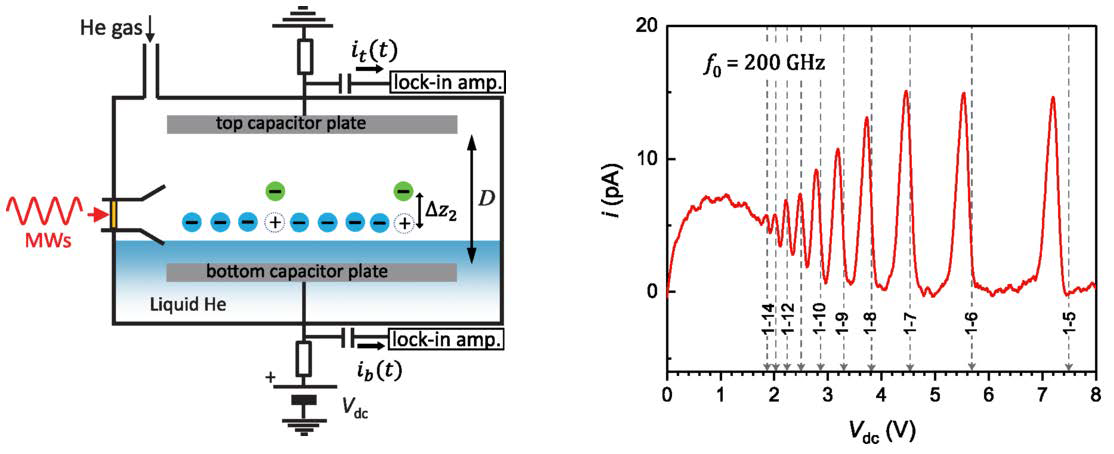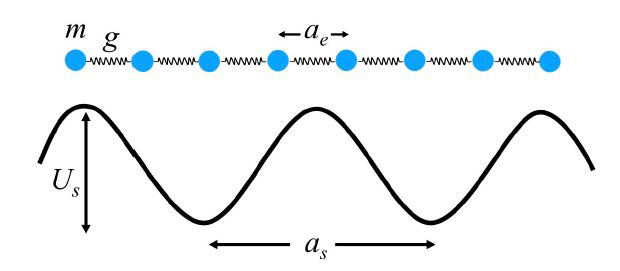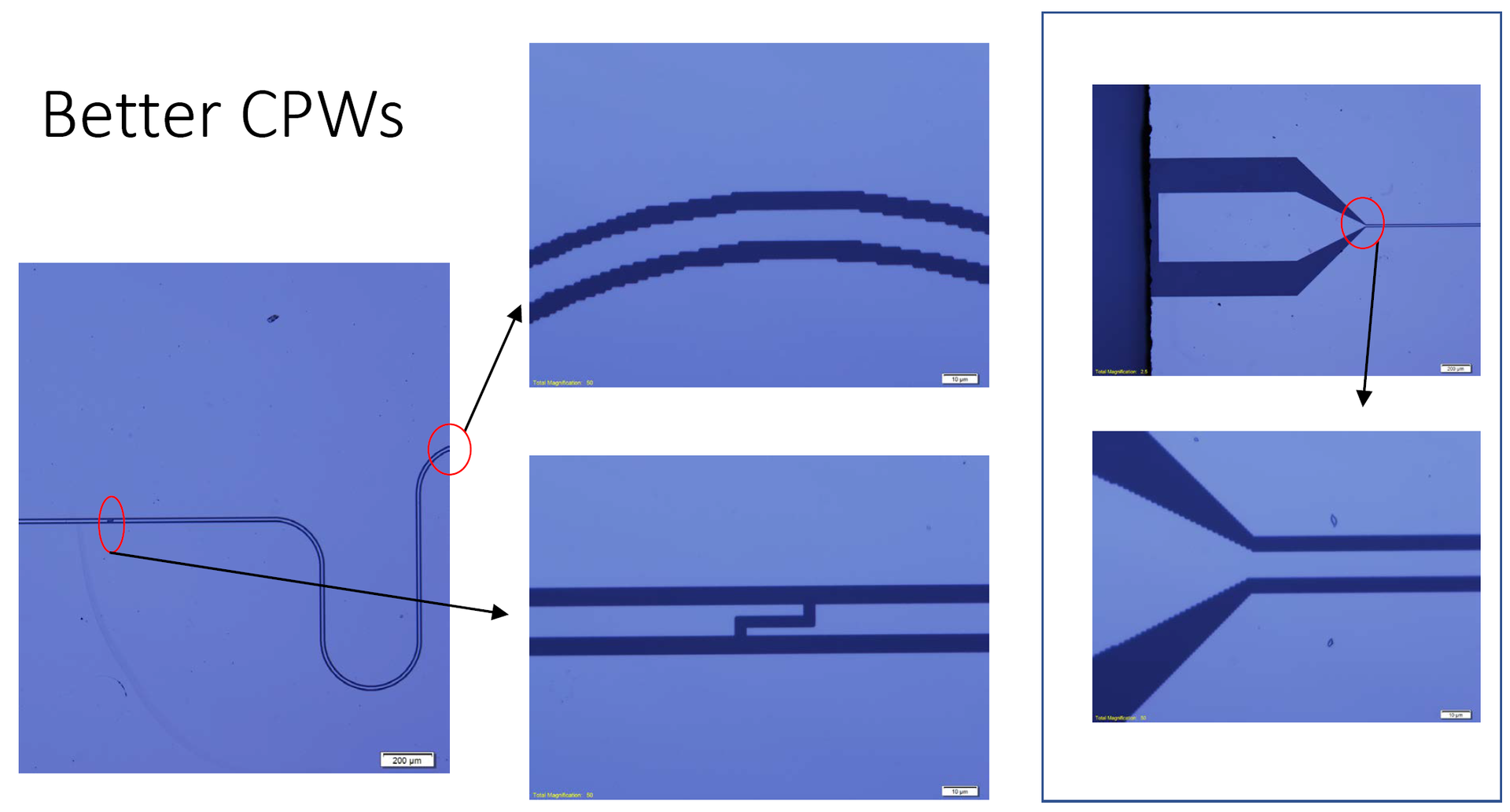FY2018 Annual Report
Quantum Dynamics Unit
Associate Professor Denis Konstantinov

(From left to right) Yoko Fujitomi, Jiabao Chen, Erika Kawakami, Emil Joseph, Reo Shinagawa, Oleksiy Zadorozhko, Denis Konstantinov, Shota Norimoto, Jason Ball, Shan Zou, Yuimaru Kubo, Peter Moroshkin, Morihiro Ohta
Abstract
In FY2018, we expanded our research activities on quantum systems and their application for quantum technologies. Large portion of these activities is related to our experimental research on electrons on helium. In particular, we showed that our new method of image-chrage detection can provide a new passway towards spin detection and spin qubits on liquid helium. Our experiments in tilted magnetic field realized coupling between electron's orbital quantum states, thus can be potentially used to engineer new quantum states. We started developing a new experimental approach to study many-body phenomena using electrons confined in microchannels, in particular to realize a simulator of the Frenkel-Kontorova model (Jui-Yin Lin, PhD 2018). Finally, we continued developing new hybrid quantum systems based on impurity spin enssembles in diamond for quantum communication and quantum sensing.
1. Staff
- Dr. Yuimaru Kubo, Staff Scientist/Group Leader
- Dr. Petr Moroshikin, Staff Scientist
- Dr. Erika Kawakami, Postdoc Scholar
- Dr. Oleksiy Zadorozhko, Postdoc Scholar
- Dr. Asem Elarabi, Postdoc Scholar
- Dr. Emil Joseph, Postdoc Scholar (Kakenhi)
- Jason Ball, PhD Student (OIST)
- Jui-Yin Lin, PhD Student (OIST)
- Jiabao Chen, PhD Student (OIST)
- Zou Shan, PhD Student (OIST)
- Morihiro Ohta, Part-time Research Assistant
- Reo Shinagawa, Part-time Research Assistant
- Jonathan Everts, Intern student (Summer)
- Yoko Fujitomi, Research Unit Administrator (Temporary)
- Tomoe Furuya, Research Unit Administrator (Temporary)
- Taki Tazuke, Research Unit Administrator
2. Collaborations
2.1 Electrons on helium in tilted magnetic field
- Description: Experimental study of 2D electrons on the surface of liquid helium in tilted magnetic field using the Stark spectroscopy method
- Type of collaboration: Joint research
- Researchers:
- Dr. Alexei Chepelinaskii, University Paris-Sud, Orsay, France
- Ms. Kamila Yunusova, University Paris-Sud, Orsay, France
- Prof. Helen Bouchiat, University Paris-Sud, Orsay, France
2.2 Low-noise HEMT amplifier for low-temperature experiments
- Description: Development of a low-noise cryogenic HEMT-based amplifier for experiments on image-charge detection of the Rydberg states of electrons on liquid helium
- Type of collaboration: Joint research
- Researchers:
- Dr. Oleksiy Rybalko, Verkin Institute for Low Temperature Phsyics and Engineering, Kharkov, Ukraine
2.3 Superconducting CPW microwave resonator
- Description: Development of a superconducting CPW microwave resonator for circuit-QED type experiments with electrons on helium
- Type of collaboration: Joint research
- Researchers:
- Prof. Kimitoshi Kono, National Chiao Tung University, Taiwan
2.4 Detection of tiny magnetic excitations using a Josephson junction spectrometer
- Description: Development of an ultra-sensitive spectrometer to detect tiny magnetic excitations based a Josephson junction spectrometer
- Type of collaboration: Joint research
- Researcher(s):
- Dr. Çağlar Girit, CNRS and College de France, France
3. Activities and Findings
3.1 Image-charge detection of the quantum Rydberg states of electrons on liquid helium (E. Kawakami, A. Elarabi) (link)
We developed a novel method to detect excitation of the Rydberg states of the orbital motion of electrons bound to the surface of liquid helium. The method is based on detection of the image current induced by the motion of the excited electrons in the capacitance plates, see Fig. 1 (left). By applying pulsed modulated microwave (MW) exciation, we could observe the excited Rydberg states up to very large quantum numbers, see Fig. 1 (right).

Figure 1: (left) Schematic diagram of the proposed image-charge detection method. (right) Experimental demonstration of the image-chrage detection method. The image current i reveals excitaion of the high-lying Rydberg states up to the quatum number n=14.
Also, we demostarted that this method can be potentially scaled down to the detection of the Rydberg state exciation of the single electron. Thus, by employing the spin-orbit intercation in a gradient of magnetic field, this method can be potentially used for detection of the spin state of a single electron.
3.2 Coupling between the orbital states of electrons on helium induced by tilted magnetic field: the Lamb shift of the Rydberg states (in collboration with K. Yunusova, H. Bouchiat and A. Chepelianskii from LPS, Univercity Paris-Sud, France)(link)
We demonstrated that introduction of the component of magnetic field parallel to the plane of a 2D electron system results in coupling between the states of the orbital in-plane motion of electrons (the Landau Levels) and the states of motion perpendicular to the 2D plane (the Rydberg states). In particular, this results in a Lamb-like shift of the energy levels of the Rydberg states due to their coupling to the "quantum oscillator" states of the Landau Levels (LLs), see Fig. 2 (e), which is analogues to the Lamb shift in atom due to their interaction with the quantized sates of electro-magnetic field.
Figure 2: (a-d) The Lamb shift of the transition frequency between the ground Rydberg states and the first two excited Rydberg states as a function of the in-plane field By. (e) Schematic diagram of the energy levels of an electron on helium and coupling between two LL-manifolds introduced by the in-plane component By of the magnetic field.
In the experiment, this Lamb shift is demonstrated in the 2D system of electrons on liquid helium by measuring the transition frequency between the ground Rydbreg state and the excited Rydberg states using the Stark spectroscopy method, see Fig. 2 (a-d).
3.3 Towards classical simulator of the Frenkel-Kontorova model (J.-Y. Lin, A. Smorodin, S. Zou, in collaboration with A. Badrutdinov from the Microfabrication and Engeneering Support Team, OIST) (link)
We started developing a new exerimental method to study classical many-body phenomena in a strongly-correlated systems, in particular a classical simulator of the Frenkel-Kontorova (KF) model, a chain of interacting particles subject to an external periodic potential, see Fig. 3.

Figure 3: Schematic diagram of the Frenkel-Kontorova model.
Our approach is to use strongly-interacting 2D electrons on the surface of liquid helium confined in microchannel structures where the electrostatic periodic potential can be introduced by the parttening of the confining electrodes. We have developed such a microchannel device where the periodic potential is introduced by an inter-digital capacitor (IDC) which comprise the bottom electrode of the microchannel, see Fig. 4.

Figure 4: False-color scanning electron micrograph of the device for experiments with electrons on helium subject to a periodic (1 micron) electrostatic potential
In the future experiments, we intend to modify and improve the microchannel device to observe key signitures predicted by teh Frenkel-Kontorova model, such as the Aubry transition and commensurability effects.
3.4 Development of a superconducting CPW microwave resonator for circuit-QED type experiments with electrons on helium (E. Joseph, in collaboration with K. Kono from the National Chiao Tung University, Taiwan)
We started develping a high-Q superconducting coplanar waveguid (CPW) microwave resonators for circuit-QED type experiments with electrons on helium. Such resonators have been already successfully used in experiments with superconducting qubits in many laboratories around the world. In this work, we used spatter deposition, optical lithography, and plazma etching methods to fabricate a Niobium CPW resonator with resonance frequency ~5 GHz. In particulr, we established that by applying the plasma (ICP) etching in CF6 produces a better-quality device, see Fig. 5.

Figure 5: Micrograph of the fabricated Niobium CPW resonators which highlights some delicate parts of the resonator.
In the future experiments, we plan to improve design of the CPW resonator to reach a high value of Q and to observe coupling of an ensemble of electrons on the surface of liquid helium to the resonator.
4. Publications
4.1 Journals
-
P. Moroshkin, K. Kono, "Zero-phonon lines in the spectra of dysprosium atoms in superfluid helium", Phys. Rev. B 99, 104512, https://doi.org/10.1103/PhysRevB.99.104512 (2019)
-
J. Chen, D. Konstantinov, K. Mølmer, "Adiabatic preparation of squeezed states of oscillators and large spin systems coupled to a two-level system", Phys. Rev. A 99, 013803, ttps://doi.org/10.1103/PhysRevA.99.013803 (2019)
-
J. Chen, A. A. Zadorozhko, D. Konstantinov, "Strong coupling of a two-dimensional electron ensemble to a single-mode cavity resonator", Phys. Rev. B 98, 235418, https://doi.org/10.1103/PhysRevB.98.235418 (2018)
-
J.-Y. Lin, A. V. Smorodin, A. O. Badrutdinov, D. Konstantinov, "Sliding of an electron crystal of finit size on the surface of superfluid 4He confined in a microchannel", Phys. Rev. B 98, 085412, https://doi.org/10.1103/PhysRevB.98.085412 (2018)
-
J.-Y. Lin, A. V. Smorodin, A. O. Badrutdinov, D. Konstantinov, Transport Properties of a Quasi-1D Wigner Solid on Liuid Helium Confined in a Microchannel with Periodic Potential, J. Low Temp. Phys. 195, 289, https://doi.org/10.1007/s10909-018-2089-7 (2018)
-
P. Moroshkin, P. Leiderer, K. Kono, "Perturbations of a Free Surface of Superfluid Helium by the Ion Wind Produced by a Corona Discharge Above the Liquid", J. Low Temp. Phys. 195, 327, https://doi.org/10.1007/s10909-018-2074-1 (2018)
-
P. Moroshkin, P. Leiderer, K. Kono, "Perturbations of a Free Surface of Superfluid Helium by the Ion Wind Produced by a Corona Discharge Above the Liquid", J. Low Temp. Phys. 195, 327, https://doi.org/10.1007/s10909-018-2074-1 (2018)
-
J. R. Ball, Y. Yamashiro, H. Sumiya, S. Onada, T. Ohshima, J. Isoya, D. Konstantinov, Y. Kubo, "Loop-gap microwave resonator for hybrid quatum systems", Appl. Phys. Lett. 112, 2014102, https://doi.org/10.1063/1.5025744 (2018)
4.2 Books and other one-time publications
Nothing to report
4.3 Oral and Poster Presentations
-
Jason Ball, "Microwave amplification by thermally-induced population inversion",
oral presenation at the 74th JPS Annual Meeting, Fukuoka, Japan. March 14-17 (2019) -
Yuimaru Kubo, "Microwave amplification by a spin maser",
oral presenation at the 74th JPS Annual Meeting, Fukuoka, Japan. March 14-17 (2019) -
Yuimaru Kubo, “Ultra-sensitive spin resonance using superconducting quantum technologies”,
Invited talk in the Photonics Symposium at the 66th Japan Society of Applied Physics (JSAP) Spring Meeting, Tokyo, Japan, March 9 (2019). -
Jason Ball, "Towards a quantum transducer with spins in diamond",
invited talk at the International Workshop on Hybrid Quatum Systems, Onna, Japan, January 8 (2019) -
Denis Konstantinov, "Image-charge detection of Rydberg states of electrons on helium",
invited talk at the International Workshop on Hybrid Quatum Systems, Onna, Japan, January 8 (2019) -
Yuimaru Kubo, "Quantum information science and technologies with hybrid systems",
Invited talk at the 3rd JSAP Photonics Workshop, Onna, Japan, December 1 (2018) -
Jason Ball, "Loop-gap microwave resonator for hybrid quantum systems",
poster presenation at the 3rd JSAP Photonics Workshop, Onna, Japan, November 30 (2018) -
Jason Ball/Yuimaru Kubo, "Strong coupling of a loop-gap resonator with impurity spins in diamond", oral presentaion at the Automn Meeting of the Japan Physical Society, Doshisha University, Kyoto, Japan, September 10 (2018)
-
Erika Kawakami, "Capacitive read-out of the Rydberg states towards the realization of a quantum computer using electrons on helium" Japan-EU Joint Workshop, Paris, France, September (2018)
-
Peter Moroshkin, “Dynamics of the free surface of superfluid 4He probed by electrically charged tracer particles”, poster presentation at the International Conference on Quantum Fluids and Solids, Tokyo, Japan, July 25-31 (2018)
-
Jui-Yin Lin, “Effects of finite size and spacial periodic modulation on on transport of Wigner solid on liquid helium confined in microchannels”, poster presentation at the International Conference on Quantum Fluids and Solids, Tokyo, Japan, July 25-31 (2018)
5. Intellectual Property Rights and Other Specific Achievements
Patent Application: “Ultra-low noise cryogenic microwave amplifier by means of spin maser,” Provisional Application filed March 4, 2019 (USA)
6. Meetings and Events
6.1 OIST/Unit organized seminars
- Date: February 25, 2019
- Venue: OIST Campus C210
- Speaker: Çağlar Girit (CNRS & College de France)
- Title: Spectroscopy with Josephson Junctions
- Date: January 7, 2019
- Venue: OIST Campus C210
- Speaker: Peter Burns (University of Colorado Boulder)
- Title: Towards quantum transduction with an improved electro-opto-mechanical converter
- Date: August 2, 2018
- Venue: OIST Campus C016
- Speaker: Asem Elarabi (Kyoto University)
- Title: Polarization properties of terahertz radiation monolithically generated from Bi2Sr2CaCu2O8+δ mesa structures
- Date: July 27, 2018
- Venue: OIST Campus C016
- Speaker: Jevon Longdell (University of Otago)
- Title: Towards quantum frequency conversion and microwave memories with Erbium dopants in YSO
- Date: July 5, 2018
- Venue: OIST Campus C700
- Speaker: Masahiro Kitagawa (Osaka University)
- Title: Quantum Information Technology in the Near Future
- Title: Hyper-sensitive MRI and Quantum Circuit Learning
- Date: July 4, 2018
- Venue: OIST Campus C700
- Speaker: Masahiro Takeoka (NICT)
- Title: Quantum information and communications research at NICT
- Speaker: Hirotaka Terai (NICT)
- Title:Superconducting device research at NICT
- Speaker: Kouichi Semba (NICT)
- Title: Light-Tatter interaction beyond ‘strong coupling’ in circuit quantum electrodynamics
- Date: May 10, 2018
- Venue: OIST Campus C016
- Speaker: Yutaka Fujii (University of Fukui)
- Title: Development of ESR measurement systems at University of Fukui
- Speaker: Akira Fukuda (Hyogo College of Medicine)
- Title: Physics in two-dimensional electron system in quantum Hall regime
- introduction of our recent research
- Date: April 26, 2018
- Venue: OIST Campus C016
- Speaker: Junichi Isoya (University of Tsukuba)
-
Title: Quantum sensing nano-NMR using a single NV center in diamond
6.2 OIST/Unit organized workshop
International Workshop on Hybrid Quantum Systems
- Date: January 8, 2019
- Venue: OIST Campus B250
- Speakers:
- Mika A. Sillanpää (Aalto University)
- Peter Burns (University of Colorado Boulder)
- Takashi Yamamoto (Osaka University)
- Jason Ball (OIST)
- Keiji Ono(RIKEN)
- Katsushi Hashimoto (Tohoku University)
- Fabian Pauly (OIST)
- Kazuhiko Hirakawa (The University of Tokyo)
- Takao Aoki (Waseda University)
- Tridib Ray (OIST)
- Denis Konstantinov(OIST)
7. The Category or Type of Funding, like External Funding, Awards, etc.
- JST-PRESTO, Grant Number JPMJPR1762: “Towards realization of a universal quantum computer using electrons on the surface of helium” (ヘリウム表面上の電子を用いた万能デジタル量子コンピューターの実現へ向けて)
-
JST-PRESTO, Grant Number JPMJPR15P7: “Towards coherent bi-directional conversion between microwave and optical photons via electron spins in solids”
(固体中の電子スピンを用いた光-マイクロ波のコヒーレント相互変換) -
Grant-in-Aid for Scientific Research (A), Grant Number 17H01145: “Single electron manipulation on liquid He surface and its application for quantum information processing”
-
Grant-in-Aid for Scientific Research (B), Grant Number 18H01817:
“Ultra-sensitive Spin Resonance using Superconducting Quantum Technology”
(超伝導量子テクノロジーを用いた超高感度スピン共鳴) -
Grant-in-Aid for Scientific Research on Innovative Areas, Grant Number 18H04295:
“Three-dimensional hybrid quantum system with superconductors and diamonds”
(ダイヤモンド-超伝導3次元ハイブリッド量子系) -
Research Support for Young Scientists by The Nakajima Foundation:
"Quantum information transducer with spins in diamond"
(ダイヤモンド中のスピンを用いた量子情報トランスデューサー)



